The Cultivation of Immortality in Modern Daoist Practice: Bridging Ancient Wisdom and Contemporary Life
IntroductionIn the heart of modern China and beyond, the ancient Daoist quest for immortality persists, adapting to contemporary life while rooted in millennia-old traditions. Daoism, with its rich tapestry of spiritual and physical practices, continues to inspire those seeking harmony, longevity, and transcendence. This article explores how Daoist immortality cultivation evolves today, blending tradition with innovation under the influence of global wellness trends and technological advancements.
Historical Roots of Daoist ImmortalityDaoist immortality (仙 xian) traditionally involves achieving harmony with the Dao, the fundamental life force. Practices include internal alchemy (neidan), which transforms the body's vital energies—Jing (essence), Qi (vital energy), and Shen (spirit)—into spiritual immortality. External alchemy (waidan), using herbal elixirs, and practices like Qigong, Tai Chi, and meditation, aimed to purify the body and mind. These methods emphasized balance, moderation, and alignment with natural rhythms.
Modern Adaptations of Ancient PracticesToday, Daoist practices are often stripped of mystical connotations, repackaged as holistic health routines. Tai Chi and Qigong flourish in urban parks worldwide, praised for reducing stress and improving physical health. Mindfulness meditation, influenced by Daoist breathing techniques, is integrated into corporate wellness programs. Monasteries like Wudang Mountain offer retreats teaching neidan and martial arts, attracting both spiritual seekers and tourists.
Technology and the New AlchemyModern aspirants fuse tradition with technology. Biohackers track Qi flow using wearable devices, while apps like "Taoist Meditation Timer" guide users through ancient techniques. Supplements claiming to replicate waidan elixirs market "longevity pills," though purists argue this commercializes sacred practices. CRISPR and cryonics are debated within Daoist circles as potential "immortality tools," reflecting a dialogue between science and spirituality.
Scientific Perspectives and Health BenefitsResearch validates aspects of Daoist practices: studies show Tai Chi enhances balance in seniors, while meditation reduces anxiety. However, science dismisses physical immortality as fantasy, focusing instead on longevity. Practitioners often reframe immortality as mental clarity and spiritual liberation, aligning with contemporary emphasis on quality of life over mere lifespan.
Cultural and Spiritual ResonanceThe allure of Daoist immortality lies in its promise of transcendence in an age of existential uncertainty. Urban professionals embrace meditation to counter burnout, while eco-conscious individuals adopt Daoist ecological principles. The philosophy of wuwei (effortless action) resonates in minimalist lifestyles, illustrating Daoism's adaptability to modern values.
Challenges and CriticismsSkeptics critique the commodification of Daoist rituals, such as expensive retreats or dubious supplements. Traditionalists fear dilution of sacred teachings, while scientists demand empirical validation. Yet, many find value in these practices as metaphors for personal growth, emphasizing their psychological over literal benefits.
ConclusionThe cultivation of immortality under Daoist influence today is less about elixirs of life and more about living mindfully in a fragmented world. By merging ancient wisdom with modern innovation, Daoism offers a path to holistic well-being, proving that the quest for immortality endures not as a literal goal, but as a metaphor for enduring peace in an ever-changing society. In this synthesis, Daoist culture remains a vibrant bridge between past and present, inviting all to explore the art of harmonious living.

Comments (0)
No comments